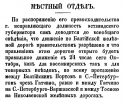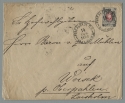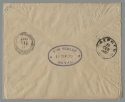Railway Post
The first railway opened in Estonia on 5th November (according to the old calendar on 24th October) in 1870 on the Paldiski-Tallinn-Narva-Gatchina line. In the same year, the new railway was connected with the Petersburg-Warsaw railway.
Five years later, a determined admirer of railway Johann Voldemar Jannsen wrote: „Once demand increased over the construction of Baltic railway, many hopelessly wagged their heads over the cost of it, considering the earnings and incomes many joked about the upcoming Baltic railway, calling it „lemon aka orange railway... . But how are things now? What wasn't believed before, now every man needs to see themselves that Baltic railway with its independent earrings stands stronger than any other railway." (Estonian Postimees, 30.04.1875)
In 1877 Tapa-Tartu railway line was opened, which extended to Valga after ten years, where it was connected with the Pskov-Riga railway.
In 1896, the first narrow-gauge railway (750 mm) was established on the Valga-Pärnu railway line, and next year railway brunch from Mõisaküla to Viljandi, then continuing towards Paide and Tallinn's seaport. Traffic started to run between those two cities in 1901.
The first railway opened in Estonia on 5th November (according to the old calendar on 24th October) in 1870 on the Paldiski-Tallinn-Narva-Gatchina line. In the same year, the new railway was connected with the Petersburg-Warsaw railway.
Five years later, a determined admirer of railway Johann Voldemar Jannsen wrote: „Once demand increased over the construction of Baltic railway, many hopelessly wagged their heads over the cost of it, considering the earnings and incomes many joked about the upcoming Baltic railway, calling it „lemon aka orange railway... . But how are things now? What wasn't believed before, now every man needs to see themselves that Baltic railway with its independent earrings stands stronger than any other railway." (Estonian Postimees, 30.04.1875)
In 1877 Tapa-Tartu railway line was opened, which extended to Valga after ten years, where it was connected with the Pskov-Riga railway.
In 1896, the first narrow-gauge railway (750 mm) was established on the Valga-Pärnu railway line, and next year railway brunch from Mõisaküla to Viljandi, then continuing towards Paide and Tallinn's seaport. Traffic started to run between those two cities in 1901.
By 1904, there were established up to 650 km worth of broad-gauge railways and 373 km narrow-gauge railways - consequently Estonian territory transformed into one of the most densely built railway brunch areas in Tsarist Russia. By the time of Estonian Independence, there were 92 railway stations and between 1918-1940 nearly 60 new stations were built.
Railway boosted the economy, freight and industry, as a result, it provided new settlements and laid grounds for new infrastructure. Also putting postage stamps into service and transferring post service from horse transport to railway, which was a tremendous milestone in history.
The official post service at Baltic railway started on 7th November (26th October) 1870. At first, the service was provided with locked or sealed bags under postman/courier surveillance. They were assigned to transport with the passenger or freight trains, give out mailbags/-bundles and also receive them.
Soon to save some time, mailbags were opened and sorted during the transportation. The next steps were moving post offices and mail wagons. The first one started out in 1838 between United Kingdom's Birmingham and Liverpool. During the Tsar, the local railway post service took orders from Petrograd's district. The first Tsarist wagon postage stamps were taken into circulation at the Gatchina-Paldiski line in 1871.
Post offices were opened in railways stations to improve the better run of postal service, at first in Tallinn (1870), Tartu and Tapa (1877), and in Valga (1889). With the year of 1915, there were 276 post offices in 80 different railway stations.
Mailwagongs as of 1915:
Nr 39/40 Petrograd-Tapa-Riga, Riga-Tapa-Petrograd
Nr 89/90 Tapa-Haapsalu, Haapsalu-Tapa
Nr 125/126 Pihkva-Pärnu, Pärnu-Pihkva
Nr 238/240 Tallinn-Mõisaküla, Mõisaküla-Tallinn
Nr 271/272 Valga-Stockmanshof, Stockmanshof-Valga
Mailwagons were different from the passenger ones. For the Chinovnik aka postal official, they were according to second class passenger wagon requirements assigned a proper room for assorting the mail, also it was necessary to have a storage availability for bigger parcels. Both mail wagon outer walls had an opening, where it was possible to push the letters into the insides boxes with covers. Over the course of the Republic of Estonia, for the safety of mail and crew, wagon doors were kept closed from inside and windows were barred. Crew possessed firearms, although it's yet to be discovered whether it was ever used. It was forbidden for passengers to enter the wagons.
According to the railway tariff regulation, the postal administration paid 20 marks for each running kilometer to the railway administration for the transportation of mail wagons.
Republic of Estonia logistics
Railway and police departments cooperated intensively over the course Estonian Independence era, by doing so they were remarkably able to save some money. Luggage and parcels were often carried in the same wagon, railway officials exchanged mailbags with postal officials in the stations and issued luggage shipments. In the final years of Estonian independence, there were located 720 postal offices in 128 railway stations and served by railway officials.
The overall length of the railway branch was 1156,7 km, where mail wagons operated. Mainly mail transport was mainly operated through the transportation departments, which operated near the bigger post offices. Their main task was transporting mail bags between railway stations, post offices, and brunch stations. The crew consisted of over 60 people all over Estonia, usually consisting of two officials, but with an exception of the Tallinn-Valga line having three officials.
Mail wagons differed from other wagons (since the beginning of the 20th century) with their dark cherry colour and depicting mail horns on both sides of the wagon.
Mail transportation with mail wagons was reestablished in the Republic of Estonia in the middle of 1919. By 1934 mail wagons lines were rationalised and 8 of them kept on working out of 16 mail wagons.
Pv (mail wagon) 1/2 Tallinn-Valga, Valga-Tallinn
Pv 3/4 Tallinn-Pärnu, Pärnu-Tallinn
Pv 5/6 Tallinn-Haapsalu, Haapsalu-Tallinn
Pv 7/8 Tapa-Narva, Narva-Tapa
Pv 9/10 Pärnu-Lelle, Lelle-Pärnu
Pv 11/12 Tartu-Petseri-Valga, Valga-Petseri-Tartu
Pv 13/14 Rapla-Virtsu, Virtsu-Rapla
Pv 15/16 Sonda-Mustvee, Mustvee-Sonda
In 1935 Railway Government and Postal Administration signed a contract under which railway stations started to receive and send out consignments from further away located post offices. Often they smelled unpleasant and dripped - there was a layer of alive piglet, fresh fish, etc. In 1935, there were next to 29 post offices a commodity agency. Railway Government rewarded the agency's employees with free travel tickets.
Stamps
Railway mail used various stamps. Temporarily dump stamps with occasional illustrations, dumps stamps (straight and round stamps with text), straight stamps named of postline, and handwritten stamps edits.
Later on, adapted permanent mail wagon stamps: two layered oval bridge stamps, two layered circle bridge stamps with railway lines and dates. For further information about stamps and mail transportation at the railway can be found from Estonian Philatelic nr 22/23 (1978); 24/25 (1979); nr 28 (1982) and from the Philatelic Handbook ( with V. Hurt and E. Ojaste).
***
The successful partnership reflects on Railway Government and Post Headquarters when during the first years of Republic Tallinn and Tartu exchanged mail bags once or twice per day and even irregularly- at the end of 1930s the numbers had six folded and everything was full on dot.
Railway mail was used in Estonia from 1870 to 1998.
Mail transport at the Estonian railway ended in 1998, the last mail wagon was on the Tallinn-Narva line as a part of the Petersburg train.
***
Railway history is long. The exhibition gives a brief glimpse from 1870 to 1940, also a couple of photos from the 1960s.
The exhibition is in two parts.
* * *
Whilst putting together the exhibition, the material was from the Estonian National Museum stamps history and private collections. Under the info button in the toolbar, you can access background information about mail history.
Enjoy!
* * *
Exhibition commitee: Eve Aab, Reigo Lokk, Oliver Hanschmidt
Photos: Arp Karm
Editor: Karin Kastehein
Literature:
Hurt, Vambola; Elmar Ojaste. Eesti. Estonia. Philately & postal history handbook. Catalogue. Stockholm, New York: Estonian Philatelic Society, 1986, lk 503–520.
Verho, Timo; Lindeblad, Jorma. Viron rautatieleimat 1870-1918, I. Raylway cancellations in Estonia (käsikiri).
Arjakas, Küllo. Eesti raudtee 140. Publisher: AS Eesti Raudtee, Tallinn, 2010. Tallinna Raamatutrükikoda.
Riigi Teataja nr 84/85, 1921.
Eesti Filatelist nr 22/23, 1978, New Yorgi Eesti Filatelistide Selts ja Eesti Filatelistide Ühing Rootsis, lk 3–32.
Eesti Filatelist nr 24/25, 1979, New Yorgi Eesti Filatelistide Selts ja Eesti Filatelistide Ühing Rootsis, lk 206–210.
Eesti Filatelist nr 16/17, 1975, New Yorgi Eesti Filatelistide Selts ja Eesti Filatelistide Ühing Rootsis, lk 71-76.
Eesti Filatelist nr 28, 1982, New Yorgi Eesti Filatelistide Selts ja Eesti Filatelistide Ühing Rootsis, lk 237–244.
Mail, telegraph, phone ja radio-institutions lists: Postiajalugu.ee.
The official post service at Baltic railway started on 7th November (26th October) 1870. At first, the service was provided with locked or sealed bags under postman/courier surveillance. They were assigned to transport with the passenger or freight trains, give out mailbags/-bundles and also receive them.
Soon to save some time, mailbags were opened and sorted during the transportation. The next steps were moving post offices and mail wagons. The first one started out in 1838 between United Kingdom's Birmingham and Liverpool. During the Tsar, the local railway post service took orders from Petrograd's district. The first Tsarist wagon postage stamps were taken into circulation at the Gatchina-Paldiski line in 1871.
Post offices were opened in railways stations to improve the better run of postal service, at first in Tallinn (1870), Tartu and Tapa (1877), and in Valga (1889). With the year of 1915, there were 276 post offices in 80 different railway stations.
Mailwagongs as of 1915:
Nr 39/40 Petrograd-Tapa-Riga, Riga-Tapa-Petrograd
Nr 89/90 Tapa-Haapsalu, Haapsalu-Tapa
Nr 125/126 Pihkva-Pärnu, Pärnu-Pihkva
Nr 238/240 Tallinn-Mõisaküla, Mõisaküla-Tallinn
Nr 271/272 Valga-Stockmanshof, Stockmanshof-Valga
Mailwagons were different from the passenger ones. For the Chinovnik aka postal official, they were according to second class passenger wagon requirements assigned a proper room for assorting the mail, also it was necessary to have a storage availability for bigger parcels. Both mail wagon outer walls had an opening, where it was possible to push the letters into the insides boxes with covers. Over the course of the Republic of Estonia, for the safety of mail and crew, wagon doors were kept closed from inside and windows were barred. Crew possessed firearms, although it's yet to be discovered whether it was ever used. It was forbidden for passengers to enter the wagons.
According to the railway tariff regulation, the postal administration paid 20 marks for each running kilometer to the railway administration for the transportation of mail wagons.
Republic of Estonia logistics
Railway and police departments cooperated intensively over the course Estonian Independence era, by doing so they were remarkably able to save some money. Luggage and parcels were often carried in the same wagon, railway officials exchanged mailbags with postal officials in the stations and issued luggage shipments. In the final years of Estonian independence, there were located 720 postal offices in 128 railway stations and served by railway officials.
The overall length of the railway branch was 1156,7 km, where mail wagons operated. Mainly mail transport was mainly operated through the transportation departments, which operated near the bigger post offices. Their main task was transporting mail bags between railway stations, post offices, and brunch stations. The crew consisted of over 60 people all over Estonia, usually consisting of two officials, but with an exception of the Tallinn-Valga line having three officials.
Mail wagons differed from other wagons (since the beginning of the 20th century) with their dark cherry colour and depicting mail horns on both sides of the wagon.
Mail transportation with mail wagons was reestablished in the Republic of Estonia in the middle of 1919. By 1934 mail wagons lines were rationalised and 8 of them kept on working out of 16 mail wagons.
Pv (mail wagon) 1/2 Tallinn-Valga, Valga-Tallinn
Pv 3/4 Tallinn-Pärnu, Pärnu-Tallinn
Pv 5/6 Tallinn-Haapsalu, Haapsalu-Tallinn
Pv 7/8 Tapa-Narva, Narva-Tapa
Pv 9/10 Pärnu-Lelle, Lelle-Pärnu
Pv 11/12 Tartu-Petseri-Valga, Valga-Petseri-Tartu
Pv 13/14 Rapla-Virtsu, Virtsu-Rapla
Pv 15/16 Sonda-Mustvee, Mustvee-Sonda
In 1935 Railway Government and Postal Administration signed a contract under which railway stations started to receive and send out consignments from further away located post offices. Often they smelled unpleasant and dripped - there was a layer of alive piglet, fresh fish, etc. In 1935, there were next to 29 post offices a commodity agency. Railway Government rewarded the agency's employees with free travel tickets.
Stamps
Railway mail used various stamps. Temporarily dump stamps with occasional illustrations, dumps stamps (straight and round stamps with text), straight stamps named of postline, and handwritten stamps edits.
Later on, adapted permanent mail wagon stamps: two layered oval bridge stamps, two layered circle bridge stamps with railway lines and dates. For further information about stamps and mail transportation at the railway can be found from Estonian Philatelic nr 22/23 (1978); 24/25 (1979); nr 28 (1982) and from the Philatelic Handbook ( with V. Hurt and E. Ojaste).
***
The successful partnership reflects on Railway Government and Post Headquarters when during the first years of Republic Tallinn and Tartu exchanged mail bags once or twice per day and even irregularly- at the end of 1930s the numbers had six folded and everything was full on dot.
Railway mail was used in Estonia from 1870 to 1998.
Mail transport at the Estonian railway ended in 1998, the last mail wagon was on the Tallinn-Narva line as a part of the Petersburg train.
***
Railway history is long. The exhibition gives a brief glimpse from 1870 to 1940, also a couple of photos from the 1960s.
The exhibition is in two parts.
* * *
Whilst putting together the exhibition, the material was from the Estonian National Museum stamps history and private collections. Under the info button in the toolbar, you can access background information about mail history.
Enjoy!
* * *
Exhibition commitee: Eve Aab, Reigo Lokk, Oliver Hanschmidt
Photos: Arp Karm
Editor: Karin Kastehein
Literature:
Hurt, Vambola; Elmar Ojaste. Eesti. Estonia. Philately & postal history handbook. Catalogue. Stockholm, New York: Estonian Philatelic Society, 1986, lk 503–520.
Verho, Timo; Lindeblad, Jorma. Viron rautatieleimat 1870-1918, I. Raylway cancellations in Estonia (käsikiri).
Arjakas, Küllo. Eesti raudtee 140. Publisher: AS Eesti Raudtee, Tallinn, 2010. Tallinna Raamatutrükikoda.
Riigi Teataja nr 84/85, 1921.
Eesti Filatelist nr 22/23, 1978, New Yorgi Eesti Filatelistide Selts ja Eesti Filatelistide Ühing Rootsis, lk 3–32.
Eesti Filatelist nr 24/25, 1979, New Yorgi Eesti Filatelistide Selts ja Eesti Filatelistide Ühing Rootsis, lk 206–210.
Eesti Filatelist nr 16/17, 1975, New Yorgi Eesti Filatelistide Selts ja Eesti Filatelistide Ühing Rootsis, lk 71-76.
Eesti Filatelist nr 28, 1982, New Yorgi Eesti Filatelistide Selts ja Eesti Filatelistide Ühing Rootsis, lk 237–244.
Mail, telegraph, phone ja radio-institutions lists: Postiajalugu.ee.

Tema Austatud Keiserliku Majesteedi korraldusel teatatakse kohaliku valitsuse Eestimaa kubermangu kohatäiturile, et valitsuse poolt on Balti raudteelliiklus lubatud alates 24. oktoobrist reisi- ja kaubarongidele kogu Balti Sadama ja S.-Peterburgi läbi Gatšino ning Gatšinost St. Peterburgi-Varsavi-Tosno Peterburi kubermangus Nikolai raudteedel.
Eestimaa Kubermangu Teataja nr 85, 24.10.1870
Eestimaa Kubermangu Teataja nr 85, 24.10.1870















